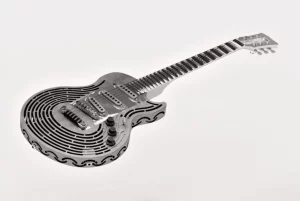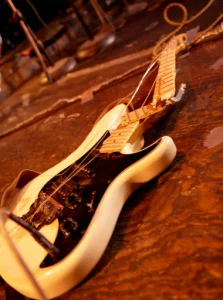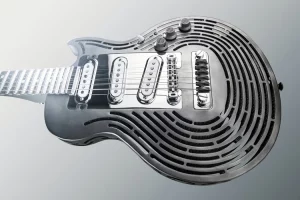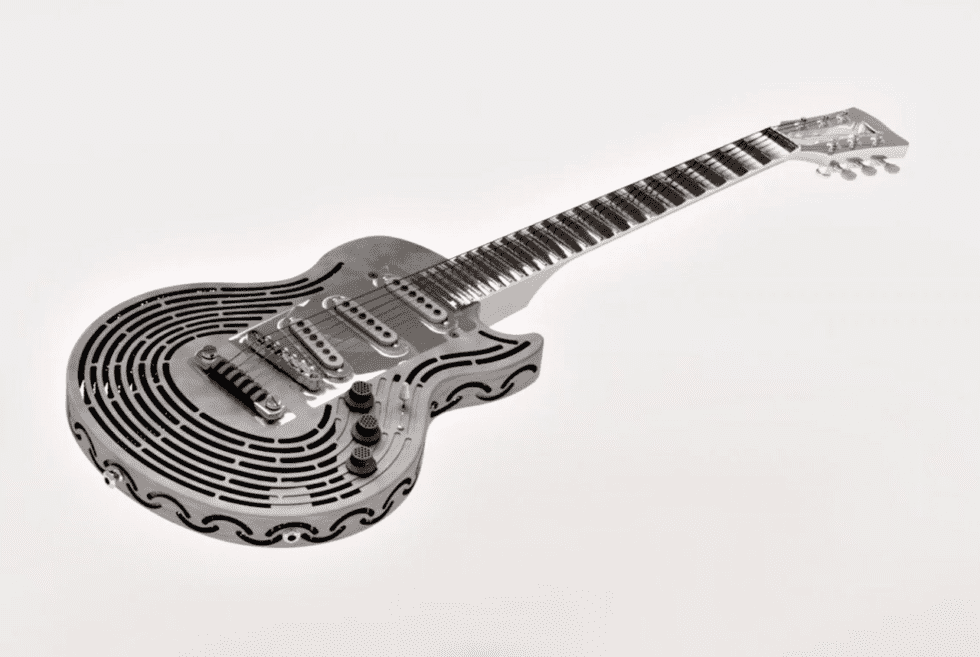It started way back in 1964 when Pete Townshend of The Who accidentally snapped the neck of his Rickenbacker during a performance. Upset about ruining his guitar, he smashed what remained of it into the stage, setting a precedent that many rockers would follow over the next decades.
Not to be upstaged, Jimi Hendrix set his black Stratocaster on fire at the 1967 Monterey Pop Festival before slamming it into the stage and tossing the blazing pieces into the audience. Over the years, many guitarists from Eddie Van Halen to Kurt Cobain have joined in the antics.
Enter the world’s first unbreakable guitar
 While no one at Sandvik Coromant set out to spoil the fun for a host of rockers, the Swedish-based supplier of cutting tools and inserts decided to create an instrument that could not be smashed, even by the most enthusiastic guitar destroyer.
While no one at Sandvik Coromant set out to spoil the fun for a host of rockers, the Swedish-based supplier of cutting tools and inserts decided to create an instrument that could not be smashed, even by the most enthusiastic guitar destroyer.
It just so happened that a machining process developer at the company, who had played guitar since his youth, idolized Yngwie Malmsteen, one of Sweden’s top guitar virtuosos and a famous (or perhaps infamous!) guitar smasher. The developer, Henrik Loikkanen, understood the challenges he was about to undertake: “We had to design a guitar that is unsmashable in all the different ways you can smash a guitar.”
The process began on YouTube
 Loikkanen started his research by watching YouTube videos of Malmsteen destroying his instruments, and he discovered that the guitars typically cracked at the joint between the neck and the body. That knowledge led the Sandvik engineers to eliminate that joint by machining the guitar’s neck and fretboard from one solid bar of stainless steel.
Loikkanen started his research by watching YouTube videos of Malmsteen destroying his instruments, and he discovered that the guitars typically cracked at the joint between the neck and the body. That knowledge led the Sandvik engineers to eliminate that joint by machining the guitar’s neck and fretboard from one solid bar of stainless steel.
Both the neck and fretboard extended into a rectangular hub that would be inserted into the guitar’s body. The fretboard and neck are long and thin and could be susceptible to distortion during the machining process. So, the company used manufacturing software to simulate the milling operation digitally before any actual cuts were made. Because of this technology, the engineers were able to select the correct tools, which ensured a smooth and efficient process.
“Precision was critical,” said Loikkanen. “Our software is built on years of experience, giving tool and the cutting data recommendations that helped us mill the fretboard down to a challenging thickness of one millimeter in places.”
A titanium body was created utilizing 3D printing technology
The next challenge—and it was a substantial one–was how to make the guitar body. What added to the complexity was the requirement for high strength with low weight.
Sandvik, with expertise in additive manufacturing, chose to 3D print the body. Lasers traced the design in beds of fine titanium powder. The process entailed fusing layers of titanium one on top of the other, each one thinner than a human hair, until the guitar’s body was built.
It was the 3D printing technology that allowed the company to produce the lightest, strongest, and most flexible components possible—something that could not have been accomplished with traditional machining methods. The additive techniques provided the extra benefit of minimizing, or eliminating, waste since the process uses only the material that’s needed for each component.
And now for the test
 Initially, one of Sandvik’s engineers tested the strength of the guitar on various items such as old furniture and equipment. But the real test was to come at a concert in Florida.
Initially, one of Sandvik’s engineers tested the strength of the guitar on various items such as old furniture and equipment. But the real test was to come at a concert in Florida.
After finishing several songs, Malmsteen proceeded to swing the guitar at amplifiers, stage structures, and the floor, giving his best efforts to destroy it. But the all-metal, unbreakable guitar foiled his attempts.
“This guitar is a beast!” Malmsteen said after giving up on his
hard work to demolish it. “To break it is impossible, but you can break other things with it!”
An unbreakable guitar is just the tip of the manufacturing iceberg
At 3DEO, 3D printing comes with unlimited potential. Here are some of the highlights of this exciting technology:
- Change designs at any time
- Order parts on-demand without minimum quantities or setup costs
- No more molds or tooling
- Production parts delivered in days, instead of months
Intelligent Layering® is 3DEO’s proprietary, patented metal 3D printing technology. For the first time in metal 3D printing, the technology’s costs are competitive with CNC machining and metal injection molding.
Contact us today for more information and enhance your competitive advantage.


